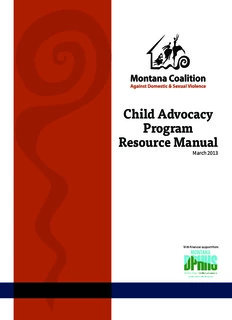
Child Advocacy Resource Manual PDF
Preview Child Advocacy Resource Manual
Child Advocacy Program Resource Manual March 2013 With financial support from: Acknowledgements The Montana Coalition Against Domestic and Sexual Violence would like to thank the following organizations and people for their assistance and input during the production of this manual. Our members and colleagues are our greatest asset, without whom we could not do the work. Montana DepartMent of HealtH anD HuMan ServiceS tHe YWca of MiSSoula tHe YWca of BillingS tHe aBBie SHelter Janet caHill crYStal BenSon And all of the national organizations and state coalitions which provided assistance and resources along the way. The views and opinions expressed herein are solely those of the Montana Coalition Against Domestic and Sexual Violence and do not reflect those of any funding or partner organization. i Montana Coalition Against Domestic and Sexual Violence | Child Advocacy Resource Manual Table of Contents Why This Manual was Created 1 Stats: Domestic Violence and Children 3 The Effects of Domestic Violence on Children 5 Voices of Children 15 Supporting Caregiver-Child Relationships 17 Program Policies and Procedures 19 Cultural Considerations 33 Resources for Advocates Working with Children 41 Appendix 77 MCADSV Library Resources for Members 99 Sources 101 iii Montana Coalition Against Domestic and Sexual Violence | Child Advocacy Resource Manual Why was this manual created? The Montana Coalition Against Domestic and Sexual Violence (MCADSV) created this manual with the input and assistance of membership programs. This manual is meant as a guide for direct service programs in the state of Montana who work with non-abusive parents and their children in domestic violence programs, shelters, and support groups. MCADSV believes that domestic violence must be addressed holistically. Non-abusive parents and their children have all been impacted by the violence perpetrated in their homes. The intention is not to direct programs or create rules, but to provide resources to those who work with children. By engaging the non-abusive parents and involving them in addressing the impacts of violence on their children, advocates can facilitate a strong familial bond and increase the parent’s understanding of the effects of violence on children. Additionally, creating a safe environment for children who are also receiving services and providing engaging, age-appropriate, and educational activities will reduce the trauma experienced in the home and increase the resiliency of the child. This manual will provide sample policies and procedures for children’s programs, information and tools for advocates, information for non-abusive parents, and curriculum suggestions for children in shelter or groups. Building a strong program to address the needs of children can lead to healing for the entire family. 1 Montana Coalition Against Domestic and Sexual Violence | Child Advocacy Resource Manual Domestic Violence and Children: Facts and Statistics Children living in violent homes are at an increased risk of experiencing violence themselves. 30 to 60 percent of children living in abusive homes are themselves abused. Perpetrators often use children to control adult victims. (See power and control wheel) Exposure to violence increases the likelihood that the child will grow to be violent. This is not a direct cause and effect, but a factor in future violent tendencies. Between 2.3 and 10 million children are exposed to intimate partner violence each year in the U.S. 500,000 children are on the scene when police respond to domestic violence calls each year in the U.S. Domestic violence occurs disproportionally in homes with children under the age of 5. 25% of domestic violence homicides are witnessed by children of the victim. Women are at an increased risk of violence during pregnancy. Women are 400% more likely to experience increased abuse during unintended or unwanted pregnancies. One study has shown that 65% of domestic violence victims that were strangled by a partner were strangled in front of their children. 43% of domestic violence victims live in households with children under the age of 12. 3 Montana Coalition Against Domestic and Sexual Violence | Child Advocacy Resource Manual
Description: